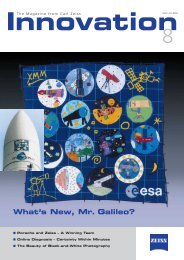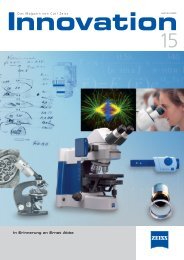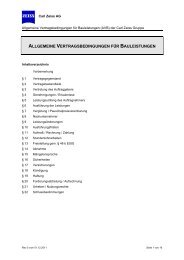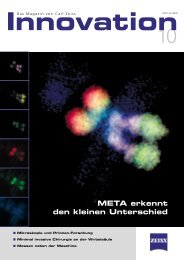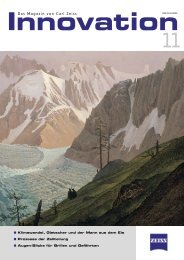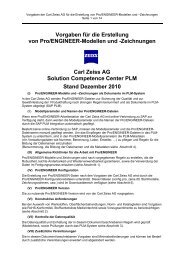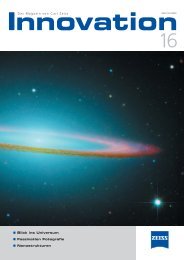Download PDF - Carl Zeiss
Download PDF - Carl Zeiss
Download PDF - Carl Zeiss
You also want an ePaper? Increase the reach of your titles
YUMPU automatically turns print PDFs into web optimized ePapers that Google loves.
3D spectroscopy – a<br />
new measuring procedure<br />
in astrophysics<br />
Since its reestablishment in 1992, the<br />
Astrophysics Institute in Potsdam<br />
(AIP) – one of the first observatories<br />
in Germany – has been advancing<br />
the targeted establishment of infrastructure<br />
for the development of<br />
modern astronomical telescopes and<br />
focal instruments in addition to its<br />
traditional fields which include stellar<br />
physics, extragalactics and cosmology.<br />
The first specific project in this<br />
area began in 1996 with the development<br />
of the PMAS (Potsdam Multi-<br />
Aperture Spectrophotometer), an innovative<br />
imaging spectrograph (Fig.<br />
1). This new technique is often<br />
referred to as integral field spectroscopy<br />
or 3D spectroscopy for<br />
short. Its measuring principle is illustrated<br />
in Fig. 2: the real image of<br />
an object, e.g. a galaxy, generated in<br />
the focal plane of the telescope is<br />
scanned using a lens scanner, with<br />
the scanner's finite number of m x n<br />
lens elements transforming the im-<br />
Innovation 16, <strong>Carl</strong> <strong>Zeiss</strong> AG, 2005<br />
age into a discrete number of m x n<br />
image elements. The light impinging<br />
on each image element is coupled<br />
from the focal plane by a dedicated<br />
fiber of a light guide bundle and<br />
transmitted to a more or less remote<br />
fiber spectrograph.<br />
By rearranging the rectangular image<br />
elements into a linear fiber array<br />
in the entry plane of the spectrograph<br />
it is very easily possible to<br />
adapt the geometry of the 2-dimensional<br />
object to the linear structure of<br />
the spectrograph slit. Each fiber is<br />
thus imaged individually by the spectrograph<br />
optics in the form of a small<br />
circle onto the CCD detector, whereby<br />
the dispersion of the diffraction<br />
grating pulls the fiber image apart to<br />
form a band of light when illuminated<br />
with a continuum; alternatively, a<br />
number of discrete points of light<br />
along this band is seen when illuminated<br />
with a spectrum of emission<br />
lines (Fig. 3). This generates a family<br />
of (m x n) spectra on the detector<br />
which can be extracted, calibrated<br />
and then combined for image reconstruction<br />
using suitable software<br />
after the image has been scanned into<br />
the computer. The result of this<br />
type of image reconstruction is called<br />
a data cube – hence the term 3D<br />
spectroscopy (Fig. 4). Depending on<br />
the view, the data cube can be interpreted<br />
as a stack of monochromatic<br />
image recordings or as a bundle of<br />
individual spectra in a rectangular<br />
array. This procedure has obvious<br />
advantages: 3D spectroscopy is a fully<br />
simultaneous measuring procedure in<br />
which the entire data set is recorded<br />
in a single exposure. As the light intensity<br />
of the majority of objects of<br />
interest in astrophysics is extremely<br />
weak and requires the use of expensive<br />
large telescopes, this aspect<br />
is becoming increasingly important,<br />
particularly for the most interesting<br />
current topics.<br />
Fig. 1:<br />
PMAS (Potsdam Multi-<br />
Aperture Spectrophotometer)<br />
at the Cassegrain focus<br />
of the <strong>Carl</strong> <strong>Zeiss</strong> 3.5 m<br />
reflecting telescope at<br />
Calar Alto Observatory<br />
in southern Spain.<br />
Fig. 2:<br />
Design principles of an<br />
integral field spectrograph<br />
with lens array and fiber<br />
coupling.<br />
Fig. 3:<br />
Part of a PMAS<br />
calibration image taken<br />
with continuous light<br />
(continuous strips) and<br />
emission line spectrum<br />
(printed points).<br />
The partial image shows<br />
two groups of 16 spectra<br />
each; the direction of<br />
dispersion is from left to<br />
right.<br />
1 2<br />
3<br />
5




